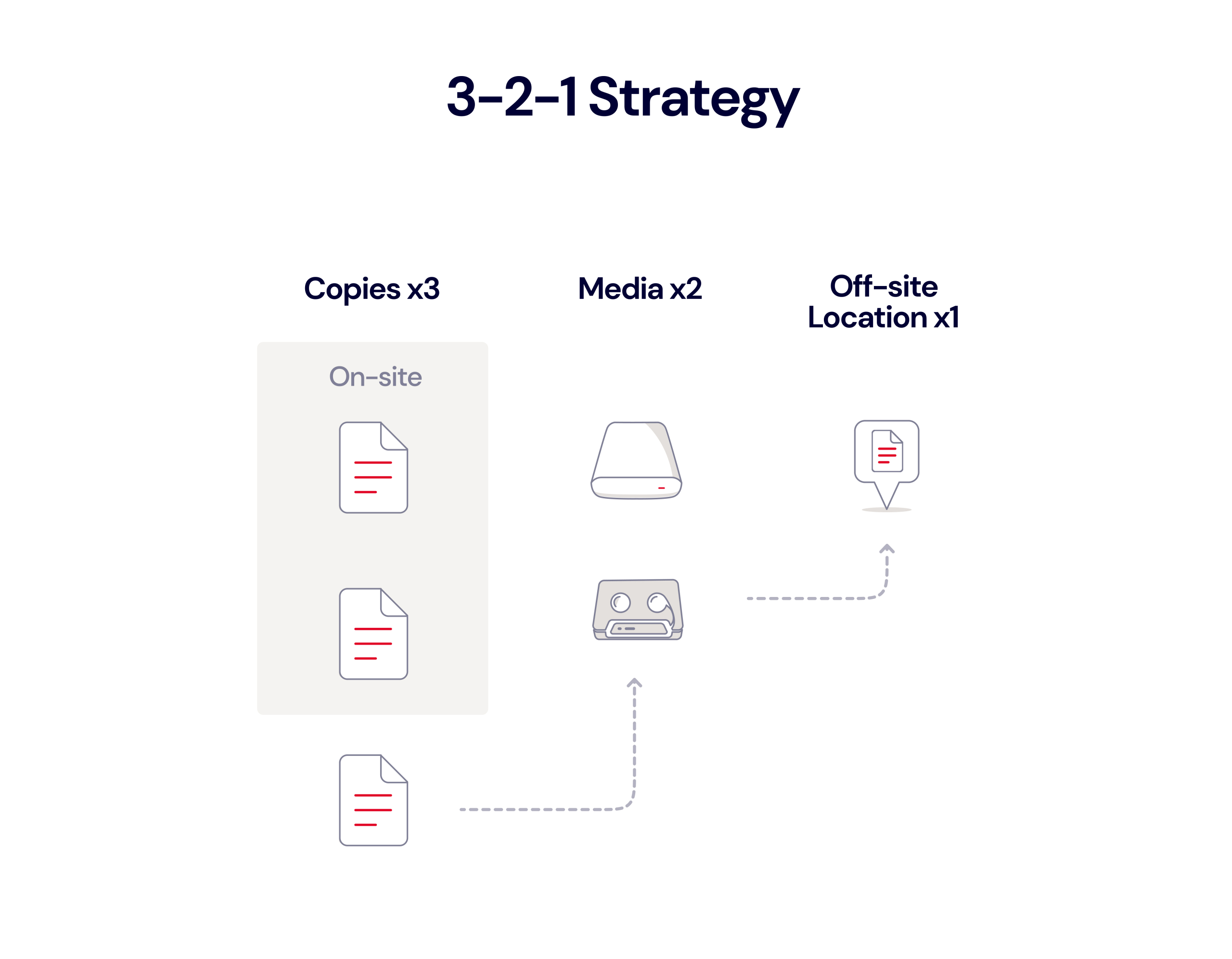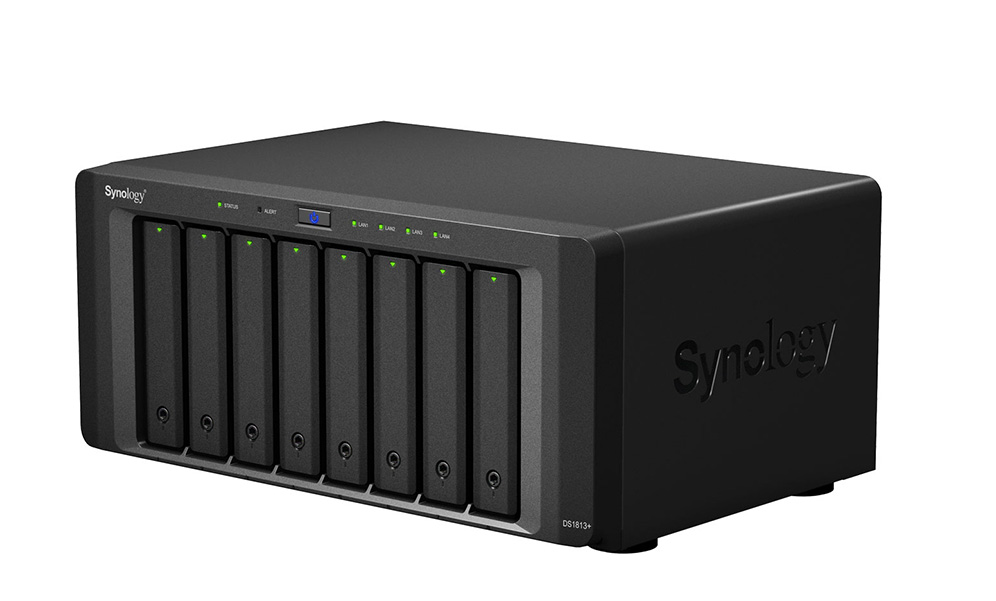
Synology network attached storage (NAS) devices are great for businesses or a home office setup. They enable easy collaboration, speed up restores, make your files accessible 24/7, and give you a level of data protection you probably didn’t have before. It’s essentially a private cloud for you or your business, and it likely stores terabytes of data you’d be lost without.
That’s why it’s important to back up your Synology DiskStation to the cloud. Your NAS offers a layer of redundancy on-premises if you happen to lose files. But, it doesn’t fully protect you from things like a natural disaster, a ransomware attack that infiltrates your backups, or multiple hard drive failures. The backups on your NAS give you easy access and fast restores, but they don’t constitute a true backup strategy.
To keep your data truly safe, the 3-2-1 backup strategy is the industry baseline. Using a 3-2-1 strategy with your NAS means you keep three copies of your data on two different media (read: devices) with one stored off-site. Backing your DiskStation up to the cloud is a great way to achieve that key off-site element.
In this post, we’ll explain how to implement a 3-2-1 backup strategy for your Synology NAS, including the benefits of backing up to cloud storage, different options for backing up your DiskStation, and some practical examples of what you can do by pairing your NAS with cloud storage.
Synology NAS and a 3-2-1 Backup Strategy
The 3-2-1 backup strategy is simple and time tested. If you are using your Synology NAS to connect and back up computers on your network, that’s the first step—you have two local copies of your data on different mediums. You’d accomplish this by creating a multi-version local copy. You might think, “Great, I’m backed up. On to the next.” However, your data is still at risk of your NAS failing. It’s also co-located with your production data, putting it at risk of disaster or theft. To avoid that, you need a third copy off-site.

For your third copy, you could back up your Synology to an external destination—either another Synology NAS, a file server, or a USB device. Each has pros and cons, and we’ll talk through them for argument’s sake.
- Back up to another Synology NAS: If you recently upgraded to a new device, you could store the third copy of your data on your old DiskStation. You get to put the old one to use, and you know it’s compatible.
- Back up to a file server: Backing your Synology NAS up to a file server is also an option, but it will take up more storage space for caching than backing up to another DiskStation.
- Back up to a USB device: Backing up to a USB device has some limited advantages—the format of your data is readable, so you can plug the USB in anywhere and access your data. However, USB backup won’t back up applications or system files, and it’s a manual rather than an automated process.
With any of these options, you’ll need to physically move your backup device—the old Synology, file server, or USB-connected device—to another location, ideally more than a few miles away, to truly achieve a 3-2-1 backup. But backing up your DiskStation to the cloud means you achieve a 3-2-1 strategy without going out of your way to physically separate the copies.
The Benefits of Backing Up Your Synology DiskStation to the Cloud
In addition to avoiding the lift of a physical move, backing up to the cloud offers a number of other benefits, too, including:
- Avoiding data loss: Obviously, this is first and foremost. Without an off-site backup, your data, including data on your individual workstations and your NAS, is susceptible to things like floods, tornadoes, hurricanes, and wildfires. Because the NAS is always connected to your machines, it’s at risk of infection from ransomware attacks. And finally, the hard drives in your NAS can fail. Because your NAS is likely set up in a RAID configuration, one drive failure might not affect your data. But, while one drive is down, your data is at a higher risk. If another drive were to fail, you could lose data. Keeping an off-site backup in cloud storage helps you avoid this fate.
- Accessibility: With your data in the cloud, your backups are accessible from anywhere. If you’re away from your desk or office and you need to retrieve a file, you can simply log in to your cloud instance and pull that file down.
- Security: Cloud vendors typically protect customer data by encrypting it as it travels to its final destination and/or when it’s at rest on the vendors’ storage servers. Encryption protocols differ between cloud vendors, so make sure to understand them as you’re evaluating cloud providers, especially if you have specific security requirements.
- Automation: Your Synology NAS comes with built-in backup utilities so you can set your cloud backup schedule in advance and move on.
- Scalability: As your data grows, your cloud backups grow with it. With cloud storage, there’s no need to invest in or maintain additional hardware to ensure your data is properly backed up.
Options for Backing Up Your Synology NAS
Hyper Backup is Synology’s built-in backup utility for backing up to any number of external destinations, including public clouds. It enables you to back up not just data stored on your NAS, but also applications and system configurations. It offers incremental backups to help you manage your storage footprint. After your initial backup, using incremental backups means only files that have been changed will be updated. It also offers cross-file deduplication to help you further manage your storage footprint. Hyper Backup allows you to back up to external devices as well as cloud services.
In addition to Hyper Backup, Synology also offers Cloud Sync, enabling you to seamlessly sync files with your cloud instance. This is a great tool for collaboration, but keep in mind that sync is not the same as backup. Cloud Sync does not support application and system configuration file backups, and it only keeps the current version of your files. If someone accidentally deletes that file, it’s gone. If you’re not sure if you’re looking for backup or sync, you can read about the differences between them in this post.
Synology offers a couple other backup methods if you’re backing up to another device, but these don’t support cloud backups. They include:
- Snapshot Replication: If your Synology model supports the Btrfs file system, using Snapshot Replication is a bit faster both on the backup side and the restore side than Hyper Backup. Snapshot Replication allows you to back up to the same Synology NAS or another Synology NAS, but not to the cloud.
- USB Copy: USB Copy only copies your data, not applications or system configuration files. It does not support cross-file deduplication, so you might end up with duplicate copies of your files. Additionally, this method is manual, and will require you to be responsible for regular backups as opposed to automating them with Hyper Backup or Snapshot Replication.

What You Can Do With Cloud Sync, Hyper Backup, and Cloud Storage
Using Hyper Backup and Cloud Sync together provides you with total control over what gets backed up to cloud storage—you can synchronize in the cloud as little or as much as you want. Here are some practical examples of what you can do with Cloud Sync, Hyper Backup, and cloud storage working together.
1. Sync or Back Up the Entire Contents of Your DiskStation to the Cloud
The DiskStation has excellent fault-tolerance—it can continue operating even when individual drive units fail—but nothing in life is foolproof. It pays to be prepared in the event of a catastrophe by syncing and backing up your entire DiskStation to cloud storage.
2. Sync or Back Up Your Most Important Media Files
Using your DiskStation to store videos, music, and photos? You’ve invested untold amounts of time, money, and effort into collecting those media files, so make sure they’re safely and securely synced to the cloud with DiskStation Cloud Sync or Hyper Backup with cloud storage.
3. Back Up Time Machine
Apple’s Time Machine software provides Mac users with reliable local backup, and many rely on it to provide that crucial first step in making sure their data is secure.
Synology enables the DiskStation to act as a network-based Time Machine backup. Those Time Machine files can be synced to the cloud, so you can make sure to have Time Machine files to restore from in the event of a critical failure.
Ready to Give It a Try?
Hyper Backup allows you to choose from any number of cloud storage providers as a backup destination, and Backblaze B2 Cloud Storage is one of them.
If you haven’t given cloud storage a try yet, you can get started now, and make sure your NAS is synced or backed up securely to the cloud.
FAQs About Synology NAS
Hyper Backup is Synology’s built-in backup utility for backing up to any number of external destinations, including public clouds. It enables you to back up not just data stored on your NAS, but also applications and system configurations. It also offers cross-file deduplication to help you further manage your storage footprint and avoid duplicates.
Synology offers a lot of options for backing up your device, including to local volumes, external devices, other Synology systems, rsync servers, or public cloud services like Backblaze B2. The best way to back up your Synology NAS depends on many different factors, but the most important thing to remember is that you should follow a 3-2-1 backup strategy. That means keeping three copies of your data on two different media (i.e. devices) with one off-site. Backing up to the cloud is a great option for handling your off-site backups.
Yes, with Hyper Backup, you can set up automatic backups to many public clouds, including Backblaze B2. It offers incremental backups to help you manage your storage footprint. After your initial backup, using incremental backups means only files that have been changed will be updated.
Synology is compatible with many public cloud providers, including Backblaze B2, Microsoft Azure, Google Cloud Platform, Amazon S3, and Synology C2 Storage.
The amount of cloud storage space needed for your Synology NAS backup depends on factors like the total data size, frequency of backups, and retention policies. Calculate your NAS data size, estimate growth, and choose a cloud plan accordingly. Synology’s Hyper Backup app provides estimates based on your backup settings, helping you select an appropriate storage plan for seamless data protection. The good thing is that as your data grows, your cloud backups grow with it. With cloud storage, there’s no need to invest in or maintain additional hardware to ensure your data is properly backed up.





